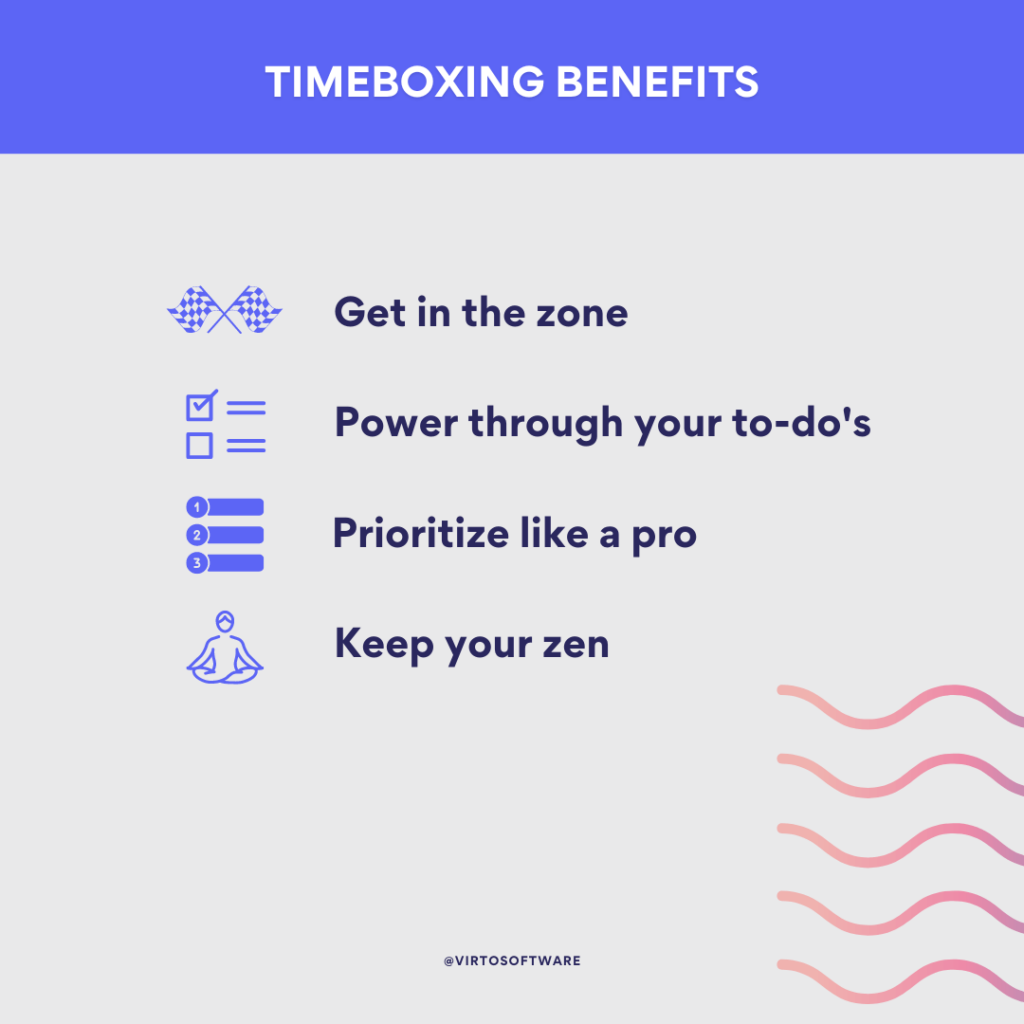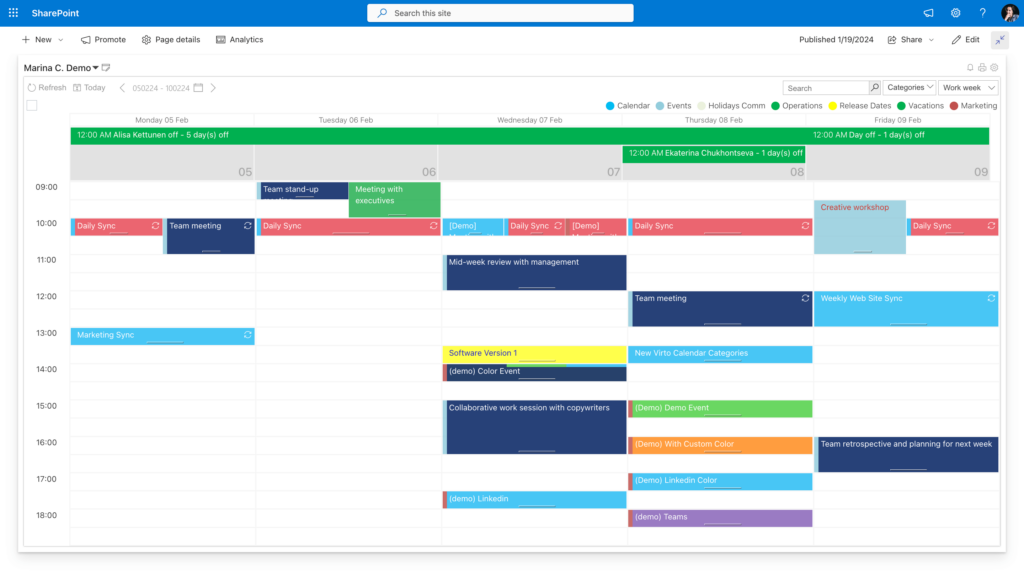A Guide to Time Boxing: Explanation, Expert Advises, Examples & Apps
Struggling to juggle your ever-expanding to-do list? Say hello to timeboxing, the #1 productivity hack according to HBR, and goodbye to overwhelming schedules.
Raise your hand if you’ve ever felt overwhelmed by an endless to-do list. The truth is, typical to-do lists often do more harm than good when it comes to productivity. They inundate us with too many options and tempt us to tackle simpler tasks first. Important but not urgent items like learning new skills get neglected. And without considering time availability, to-do lists lack crucial context.
Timeboxing offers a smarter solution. This technique schedules tasks into defined time slots, providing structure and commitment. No wonder timeboxing ranked number one in Harvard Business Review’s study of 100 productivity hacks (1).
With post-pandemic one-on-one meetings skyrocketing over 500% (2), calendar management is now make-or-break. Yet without a strategic approach, keeping up with the influx of meetings while remaining productive is nearly impossible.
This is where our expertise comes in. As a Microsoft Teams and Outlook calendar developer with over 15 years of experience, we at VirtoSoftware have accumulated extensive calendar management insights to share.
In this article, we’ll explain what a timeboxing technique is and how to use it effectively. You’ll get practical tips for integrating it into your daily workflow and setting up timeboxing across major calendars. We’ll also cover when time box management may not be suitable and how it differs from other popular time and productivity techniques.
This article is part of our ongoing series on optimizing time management through calendar tools. Be sure to check out our other installments on calendar best practices, color coding, top team calendars, and more. Together, these tips will empower you to work smarter and maximize productivity:
- Best Shared Calendars for Teams
- Why (How) To Color Code Your Calendar
- Category Ideas for Your Calendar
- Guide to Effective Calendar Management
- Best Task Management Software
- Time Focusing Explained
- Guide to Effective Time Blocking
What Is Time Boxing?
We’ve all heard the saying “time is money.” And according to Salary.com, poor time management takes a real financial toll on companies. This shows why mastering techniques like timeboxing is so critical.
But what is the timeboxing method? Timeboxing helps prioritize your tasks while maintaining a healthy work-life balance. It works by assigning a fixed, non-negotiable time slot for an activity upfront. Then you keep laser focused on that task during the allotted period. When time’s up, you stop—no matter if you’ve finished or not. This pushes you to work efficiently and focus on results.
👉What is time block or slot? In time boxing, a “time block” refers to a scheduled chunk of uninterrupted time where you focus on a particular activity.
While created for agile software development originally, timeboxing is now used far more widely as a time management tool.
It’s a simple but powerful concept. Give a task a set time period, or “timebox”, to work on it. The timebox can be soft, with some flexibility on duration, or hard, with a strict cutoff time. This lets you tailor it to the task and your needs.
Adding timeboxing to your daily routine can really improve your ability to manage time and stay organized. The ticking timer forces you to make quick decisions and zero in on critical actions. Before you know it, you get more done in less time.
The Benefits of Time Boxing
Timeboxing can work wonders for your productivity and restore sanity to your schedule. Let’s look at some of the key advantages:
- Get more done and stay on task: We’ve all experienced those painful productivity killers—distractions, interruptions, losing focus. Timeboxing helps minimize those. By committing to distraction-free timeboxes, you can work way more efficiently. Software developers use timeboxing to code with laser focus and smash through tasks.
- Figure out what really matters: Timeboxing forces you to evaluate what’s truly important. Rather than perfecting a task, you aim to make the most progress possible within the allotted time. This compels you to prioritize high-impact activities first. It brings clarity on what you can realistically do in a given period.
- Stay calm and carry on: Timeboxing sets clear limits on tasks so they don’t keep dragging on. Knowing there’s a finishing line alleviates that overwhelmed, out-of-control feeling. Marketing pros feel less anxious when they timebox campaign planning, since there’s a defined endpoint. Not letting tasks bleed endlessly into your personal time also prevents burnout.

Infographic 1. Time boxing benefits.
Plus, a multitude of other advantages for enhancing your work routine:
- Tackling unpleasant tasks: We all have those tedious or unpleasant to-dos we despise. A short timebox makes them feel more manageable. You’re forced to finally tackle them.
- Stop endless busywork: Timeboxing lets you limit time spent on lower-priority busywork. Small recurring timeboxes allow you to chip away without getting bogged down.
- Addressing minor tasks: Ever forget to respond to a 2-minute email for days? A focused timebox, even if super short, ensures quick tasks don’t slip through the cracks.
- Breaking down daunting tasks: Large intimidating projects stall progress. The timeboxing technique lets you break them into bite-sized pieces and build momentum.
- Curbing perfectionism: Hard to obsess over details with only 25 minutes, right? Timeboxes keep you focused on the vital few tasks.
- Enhancing motivation: Nothing motivates like a ticking timer. Timeboxes help you tune out distractions and dig in. Mini-challenges within timeboxes take motivation up a notch.
- Balancing your life: Timeboxing prevents you from overinvesting in some activities while neglecting others. Limit meetings and dedicate family time.
So, what are the benefits of timeboxing for productivity? By putting time limits on tasks, timeboxing forces you to focus and work efficiently instead of procrastinating. It also brings order to the chaos by providing clear deadlines that help you prioritize and make decisions quickly. No more wandering around wondering what to do next. And with the structure it gives your day, timeboxing allows for way better planning and time management overall.
Does Time Boxing Really Work?
Timeboxing can seriously boost productivity in all kinds of real-life and work situations. After checking out some real-world stories and online talks about timeboxing, it’s clear the technique can work magic if applied right. Let’s look at some examples that show how timeboxing can be adapted to different needs:
- Daily planning with a structured schedule: One organized individual shared how they map out their full day hour-by-hour in Google Calendar, adjusting as needed for pressing tasks. This accountability keeps them focused, avoiding social media rabbit holes. The takeaway is that diligently timeboxing each day prevents chaos and lost productivity. Another user explained how scheduling every single activity down to breaks transformed their work habits. Timeboxing made them more responsive, productive, and in command of their workload. It also trained colleagues to respect their boundaries, improving the whole office environment.
- Flex blocks and focus blocks: One user alternates “flex blocks” for buffer time with “focus blocks” for deep work. This builds in flexibility to stay productive when tasks run over or they’re focused and want to continue past the allotted time. Another user estimates tasks with a 20% time buffer added on. This timeboxing approach allows room for unexpected delays and ensures completion without too much unnecessary pressure.
- Timeboxing for ‘Me Time,’ days off, and personal projects: A clever timeboxing trick one person shared was mapping out all their major to-do’s at the start of each week, deliberately blocking off time for “me time” and passion projects. This shows how timeboxing can help safeguard space for personal activities and self-care, not just work tasks. Another timeboxing pro schedules focused bursts on their personal goals daily, even with a hectic full-time job. For them, timeboxing has been the secret to nurturing both professional and personal development.
- Timeboxing as a strategy for cleaning: A user explained how the timeboxing technique could be applied to an open-ended task such as cleaning a living room. Instead of cleaning indefinitely, they would spend a fixed hour on the task. This example illustrates how timeboxing can help to avoid over-investing time in tasks that don’t require perfection but just need to be “good enough.”
- Setting limits for complex investigations: In professional settings, timeboxing helps focus investigative work. One IT professional shared how they use timeboxing to set limits on troubleshooting tickets—for example, allowing just one day to investigate an unclear request before deciding if more time is warranted. This demonstrates how timeboxing can empower decision-making and resource allocation in technical environments. By capping the time spent assessing issues, teams can prioritize what receives extended efforts versus what gets parked or handed off.
These success stories from different individuals in various contexts show that timeboxing is a versatile tool that can enhance productivity, balance work and personal life, and reduce stress by providing structure and limits to one’s daily routine. Whether it’s for managing a hectic schedule, focusing on personal projects, or ensuring that all aspects of life receive attention, timeboxing has proven to deliver.
Debunking common misconceptions about time boxing
Some people believe that timeboxing is a waste of time, but this is far from the truth. With the right strategy and approach, timeboxing can transform the way you manage your tasks, both big and small. To clear the air and help you harness the full potential of this powerful productivity technique, let’s address and debunk some of the most common misconceptions about timeboxing.
| Too rigid | Just for work | Timeboxes of equal length | One-size-fits-all |
| Only works for short-term tasks | Requires clock watching | Stifles creativity | Waste of time |
Myth: Timeboxing is too rigid.
Reality: Though time boxing involves setting specific time frames for tasks, it can actually introduce greater flexibility. It’s about dedicating blocks of time to certain tasks, not micromanaging every minute. Adjustments can be made as needed.
Myth: Timeboxing is just for work.
Reality: Time boxing can be applied to any aspect of life, including personal goals, hobbies, and self-care. It’s a versatile tool that helps manage various types of tasks effectively.
Myth: All timeboxes must be equal length.
Reality: The duration of a time box should vary based on the task’s complexity and priority. It allows for more realistic planning and helps allocate appropriate time to each task.
Myth: Timeboxing is one-size-fits-all.
Reality: Time boxing is highly customizable. Individuals can adjust the lengths of time boxes and the method itself to fit their unique work style and preferences.
Myth: Timeboxing only works for short-term tasks.
Reality: Time boxing can be used for both short and long-term tasks. Long-term projects can be broken down into smaller, timeboxed segments, making them more manageable.
Myth: Timeboxing requires rigid clock watching.
Reality: While time boxing encourages adherence to set times, it’s also about prioritizing and can be adjusted when necessary. The key is to use it as a guide rather than a strict rule.
Myth: Timeboxing stifles creativity.
Reality: Time boxing can actually boost creativity by reducing the pressure of time constraints and providing dedicated space for creative thinking without distractions.
Myth: Timeboxing is a waste of time.
Reality: Time boxing is an investment in productivity. Spending a short period planning and organizing tasks can lead to more efficient use of time overall.
So, does time boxing work? Yes, it does. Well, at least for some people! The great thing about timeboxing is that you can customize it to work for your needs. Since you are in control, you can tailor timeboxing to match your ideal workflow and priorities.
How to Start Using Time Boxing
If you’re asking yourself “how do I start timeboxing,” then this section is for you!
Here’s your step-by-step guide to get started with time boxing:
| Step 1 | Preparing for timeboxing: defining objectives and selecting relevant tools |
| Step 2 | Setting time frames, including box duration and breaks |
| Step 3 | Scheduling tasks: listing tasks & prioritizing |
| Step 4 | Starting timeboxing: setting timers and sticking to them |
| Step 5 | Taking a break, evaluating progress, and readjusting |
| Step 6 | Repeating the process while tweaking time boxes as required |
| Step 7 | Adapting and optimizing your schedule for success |
Step 1: Preparation for use
Defining objectives:
- Understand the approach: Learn the difference between hard and soft methods. A hard method is strict, with no flexibility on the end time, while a soft method allows for some wiggle room if tasks are not completed within the time box.
- Task selection: You can timebox any task, but it’s particularly beneficial to choose tasks for which you lack motivation or tasks that tend to stretch indefinitely.
For instance, these might be complex tasks that you keep putting off, like drafting a novel or compiling a lengthy research paper. Breaking these tasks into smaller segments, each with its own deadline, can make them more approachable, requiring only enough motivation to reach the next milestone. Otherwise, these tasks could be necessary yet mundane, such as organizing your inbox or tidying your space, which you might delay or spend too much time on. Setting a firm deadline prevents you from dedicating more time than necessary.
- Define objectives: Identify what you aim to achieve with each task and set a timeline.
For instance, if you have a month to write a 10,000-word paper, aim to write a specific word count daily. If you need to write 400 words daily, you’ll finish in 25 days, leaving room for revisions. For less motivating tasks, setting the task itself as a goal within a timebox, like cleaning for 15 minutes each day, can lead to significant progress over time without being overwhelming.
Selecting a tool:
- Choose your tools: Decide whether you’ll use analog methods like paper and pen or digital tools such as apps and calendars. If you’re tech-savvy, you may opt for timeboxing apps that can integrate with digital calendars. We’ll talk more on digital apps later.
Step 2: Setting time frames
- Select the box duration: Choose when to start and stop working on a task.
So, how to determine the appropriate timeboxing duration for a task? When setting a timebox, think about the complexity of the task, your familiarity with similar work, and any deadline urgency. For demanding tasks, opt for a concise, optimal timebox at first.
For example, limit writing and editing a paper to 3 hours daily, marking it on your calendar. You might break these 3 hours into shorter timeboxes with breaks, applying the Pomodoro technique for efficiency.
Ultimately, the optimal human timebox is unique for each person and task. The popular Pomodoro method suggests 25-minute blocks of focused work separated by 5-minute breaks is productive for many. After 4 Pomodoros, take a 15-30 minute respite. For deep work or tasks needing longer focus, 50-90 minute timeboxes can be effective if balanced with sufficient breaks to recharge. Remember, the ideal timebox complements your personal rhythm, task nature, and attention span.
Selecting the time of day for your timeboxing technique can also be strategic; tackle the toughest tasks in the morning, as recommended by productivity experts. With experience, you’ll get better at accurately estimating how long tasks take.
- Breaks between boxes: Decide on regular short breaks, such as 5 minutes after each time box, to recharge and prepare for the next task.
Step 3: Scheduling tasks
- List tasks: Write down the tasks you need to complete for the day or session.
- Prioritize: Order tasks based on their urgency and importance to ensure that critical tasks get timeboxed first.
Step 4: Start time boxing
- Set a timer: Begin your tasks without delay, working through them according to your schedule. Use time-tracking to stay within the allotted period.
- Deep work: Work exclusively on the chosen task for the duration of the time box without distractions.
Step 5: Break and assess
- Rest: Take your planned break to relax and step back from work.
- Evaluate: Review the work completed and assess the effectiveness of the time box in helping you progress towards your goals.
Step 6: Repeat the process
- Continue time boxing: Apply time boxing to subsequent tasks, using the insight gained from previous sessions.
- Tweak durations: As you become more accustomed to time boxing, adjust the length of your time boxes to find what works best for you.
Step 7: Adaptation and optimization
- Personalize the method: Modify the time boxing technique to better fit your work style and preferences.
- Iterate for improvement: Continually refine your time boxing plan, taking into account the outcomes and how well they align with your objectives.
While optional, dangling a carrot at the end of your timebox can be a powerful motivator. After hitting your goals within the prescribed time, celebrate with an enjoyable activity. These small wins are pivotal to timeboxing success. Rewards reinforce the benefits of staying laser-focused during future timeboxes. Meanwhile, forfeiting a reward due to wandering focus can propel you to double down on timebox triumphs moving forward. In essence, rewards and their absence both drive home the value of timeboxing commitment.
By starting small and customizing timeboxes to suit your work style, their productivity-boosting power will soon become clear. Timeboxing requires finding the right groove through trial and error. Adapt the technique until it clicks. With the proper balance, you can optimize any workflow.
Overcoming the initial difficulties of time boxing practice
Implementing timeboxing can take some adjustment. While rewards and leisure time help ease the transition, other techniques can also help you overcome early struggles:
- Start with short intervals: Begin by timeboxing tiny time chunks of work to get accustomed to the discipline without feeling overwhelmed. Start with 15 minutes and scale up from there.
- Choose simple tasks: Pick simple tasks at first to notch some quick wins, building confidence in the technique. Identify top priorities and timebox those first to maximize impact.
- Identify key priorities: Spotlight must-do priorities first. Timeboxing your most critical tasks packs the biggest punch.
- Set clear goals: Paint a vivid vision of success within each box. Well-defined goals provide essential direction and motivation.
- Use timers and notifications: Employ digital tools like timers and alerts as boxing time wingmen. External soundboards reinforce your allotted time boundaries.
- Experiment with schedule: Experiment with varying schedules to unlock your prime timebox times and durations. There’s no one-size-fits-all, so customize what works best.
- Don’t be afraid of breaks: Schedule timely timeouts to recharge. Short breaks prevent burnout, sustaining laser focus across longer timeboxes.
- Record your progress: Track tasks accomplished per box to visualize progress. Charting your timeboxing success will propel you forward.
- Seek feedback and support: Seek wisdom from mentors and peers to gain new perspectives. Their feedback and encouragement can inspire breakthroughs.
- Apply creativity: Make boxing times your own through creative customization. Personalize it to complement your workflow and personality.
- Create a ritual: Institute pre and post-box rituals to add meaning like checkpoints and celebrations.
- Capture improvements: Log productivity and stress improvements since adopting timeboxing. Recognizing the benefits will keep you locked in.
Switching to timeboxing can raise some questions as you figure out how to integrate it into your life. We’ve put together some common questions with helpful answers to guide you. If you don’t see your specific question, reach out! At VirtoSoftware, we’re happy to answer any time and calendar management questions and help you find an approach that fits you and your team.
| Questions | Answers |
| How to adjust timeboxing for different types of tasks? | Timeboxes can be adjusted to suit different types of tasks. For complex, high-priority tasks, set longer timebox durations to account for the extra effort required. Simpler, routine tasks often need less time, so shorter timeboxes may work better. The key is flexibility—be ready to adapt timeboxes as you learn how much time specific tasks really take. |
| How to adjust timeboxing for tasks with multiple steps? | For tasks involving multiple steps, break down the larger task into individual components and assign a timebox to each component. This makes a complex, multi-layered task more digestible by dividing it into clear stages. Timeboxing each step creates a structured schedule that maps out the overall workflow from start to finish. It provides clarity on what sub-tasks need to be accomplished and how much time to spend on each. |
| How to prioritize tasks with multiple steps for timeboxing? | When timeboxing a multi-step task, prioritize the most crucial components that propel the project forward. Identify steps with dependencies that block progress if delayed. Also consider impact – which ones will have the greatest effect on the end goal? And factor in urgency too. Ranking steps by importance, influence, and time sensitivity allows logical timebox prioritization. |
| How to adjust timeboxing for tasks with unclear goals? | When facing a task with unclear goals, use short timeboxes for brainstorming and outlining objectives. Dedicate these initial timeboxes to thinking through and defining what you want to accomplish. Planning upfront provides the direction needed to create more targeted timeboxes moving forward. |
| How to adjust timeboxing for tasks with unexpected obstacles? | When unexpected obstacles crop up during a timebox, take a beat to reevaluate. Consider extending the current timebox if you’re close to finishing. Or schedule a new timebox dedicated to tackling this surprise challenge. You may even need to reshuffle tasks for the day if it requires an extensive delay. The key is staying adaptable in the face of detours. |
Examples of Effective Use of Time Boxing Techniques
Here’s how different types of professionals can use timeboxing effectively:
Creative workers (designers and copywriters):
- Idea generation: Set a time box to brainstorm concepts without interruption.
- Drafting and editing: Allocate specific periods for creating the first drafts and separate time for revising them.
- Research: Timebox periods for research to avoid falling into endless browsing.
- Collaboration: Schedule blocks of time for meetings with clients or team members to review creative work.
Leaders and managers:
- Strategic planning: Dedicate time boxes for long-term planning without daily operational interruptions.
- Email and communication: Limit time spent on emails and communication to prevent it from taking over the day.
- One-on-ones: Schedule regular, time-boxed meetings with team members to ensure consistent support without overrunning.
- Problem-Solving: Allocate time for addressing issues, ensuring they receive attention but don’t consume the day.
Sales managers:
- Lead generation: Timebox specific periods for researching and identifying new leads.
- Outreach: Set aside blocks of time for calls and emails to potential clients.
- Follow-ups: Have dedicated time slots for following up with leads to stay on top of potential sales.
- Training: Timebox weekly sessions for the professional development of the sales team.
Here’s a color-coded sample schedule for a designer in the VirtoCalendar Overlay App that clearly outlines work on three distinct design projects labeled A, B, and C. The schedule is interspersed with administrative tasks and slots for meetings with clients and team members, each category marked in its own unique color for easy reference and comprehension. Lunch breaks are prominently highlighted in red to ensure visibility and prevent overlap with other activities. Additionally, the schedule incorporates time for creative pursuits such as personal development and collaborative sessions:
Timeboxing in Agile Software Development
Timeboxing is often used in Agile software development, including the Scrum framework, to allocate a fixed time period to each planned activity. For instance, agile projects often establish a strict 15-minute time-box for daily stand-up meetings, though this duration can be adjusted according to specific needs. In Agile, a timebox serves as a deadline, helping to mitigate risk by using precise planning methods to foster successful results.
Instead of continuing to work until a task is finished, Agile timeboxing involves stopping work when the designated time has elapsed and reviewing the completed work.
The duration of timeboxes can range from a single day to multiple weeks, with the goal typically being to deliver a specific outcome within the set timeframe. This approach creates a concentrated work environment, encouraging teams to work collaboratively towards a complete and meaningful objective.
In Agile, you may often hear the terms sprints and timeboxes being used as if they were synonymous, but it’s important to understand that these are related but different concepts. A sprint is a specific iteration period within the Scrum framework where the development team works to complete a defined set of tasks and make them ready for review. The sprint represents a cycle of development focused on turning selected items from the product backlog into a usable product increment. In contrast, timeboxing involves setting a fixed maximum unit of time to any activity, not just sprints.
That said, boxing time plays a crucial role within sprints to help:
- Set the sprint tempo: Sprints adhere to a fixed, regular duration—typically ranging from one to four weeks—facilitating a consistent production pace for teams.
- Scope the workload: The team selects backlog items they feel they can pull off within the sprint’s timebox, given their velocity as a team.
- Rein in meetings: Scrum activities such as daily stand-ups, sprint planning meetings, sprint reviews, and retrospectives are also timeboxed to keep them focused and efficient.
- Manage expectations: If a task is taking longer than timeboxed for, the scope becomes negotiable. Either it gets adjusted to fit the timeframe, or it waits for a future sprint.
So, to put it briefly, timeboxing adds the urgency of a ticking stopwatch to agile’s iterative approach. Work is accomplished in intense bursts within strict time limits to maximize productivity. The timer keeps teams on their toes and laser focused on delivering value.
Time Boxing and Other Popular Calendar Management Techniques
Timeboxing is just one of the many time management techniques that can be applied to your daily scheduling. Other popular methods include time blocking and focusing. While related, these methods have distinct features that can determine which works best for your needs. Here, we’re going to quickly run through the key differences between these time management practices, but for a deeper dive, be sure to check out the following articles:
- Focus Management & Deep Work Explained
- Time Blocking Technique Explained
Time Boxing vs. Time Blocking
As discussed, time boxing sets a fixed time limit for a task, forcing you to stop when time runs out, even if the task isn’t finished. This constraint helps contain potentially endless tasks. Time boxing offers little flexibility—the clock waits for no task.
In contrast, time blocking divides your day into blocks dedicated to certain activities. If a task exceeds its block, you can prolong the block to complete it, if time permits. Time blocking provides structure through time segments but with some wiggle room for overrunning tasks.
Time Boxing vs. Time Focusing
So, with time boxing, you set a definite time limit on how long you’ll spend on a task before moving on. Time focusing is less rigid—it’s about setting aside time to really dig into a task without watching the clock. The idea is to create space for deep, focused work where you can engage fully with quality over quantity. Time focusing emphasizes an uninterrupted work environment and removing distractions so you can immerse yourself in the task. Rather than enforcing a strict time limit, it’s about being flexible and spending the time needed to do the work well. The priority is depth, not duration.
For a clear visual breakdown of how these methods compare, have a look at the table below:
| Time Boxing | Time Blocking | Time Focusing | |
|---|---|---|---|
| Definition | Setting aside a specific period for a task, after which the task is stopped or reassessed. | Scheduling specific blocks of time for tasks, with more flexibility to extend if required. | Prioritizing time for deep work without a strict time limit, emphasizing focus over duration. |
| Flexibility | Low flexibility; the end time is firm. | Moderate flexibility; blocks can be extended. | High flexibility; duration is not strictly defined. |
| Approach to tasks | Task-oriented; focus is on completing the task within the timebox. | Calendar-oriented; tasks are scheduled like appointments. | Priority-oriented; tasks are approached with a focus on importance and depth, not time. |
| Level of detail of tasks | Tasks are often broken down into smaller, manageable components. | Tasks can be broad or detailed, depending on how they are blocked out. | Tasks may be broad, allowing for deep engagement with the subject. |
| Interruption management | Strict; interruptions are typically not allowed within the timebox. | Managed; some room for adjusting blocks to accommodate interruptions. | Flexible; emphasis on minimizing interruptions but with more room for adjustment. |
| Suitability | Suitable for deadline-driven work and completing tasks incrementally. | Suitable for managing daily schedules and ensuring time is allocated to different tasks. | Suitable for work requiring deep concentration and minimal distractions. |
Which time management method to choose
The best time management approach depends on your specific needs and work style:
- Use time boxing if you want to limit open-ended tasks, overcome perfectionism, make faster decisions, or meet pressing deadlines.
- Time blocking is ideal if you like visual structure, have variable tasks, want to theme your day, or reduce task-switching.
- Time focusing works well for deep work like writing, coding or design, to enhance quality without rushing, or to solve complex problems requiring full concentration.
The techniques of time blocking, time focusing, and time boxing can be combined in helpful ways. For example, you could use time blocking to plan out your day, reserving certain blocks of time for deep, focused work. Within those blocks, you could apply time boxing to keep yourself on track for specific tasks.
However, it’s good to be aware of possible conflicts between the techniques. Time boxing could cut a deep work session short if you’re really in the zone, which may not be ideal. And time focusing isn’t the best fit for tasks that need to be done right away—time boxing would be better there. Also, scheduling too many time blocks back-to-back may overload your schedule, leaving no space for the deep focus that time focusing needs.
The key is to thoughtfully combine and adapt the techniques to support your goals and workflow.
To determine which method works best for you, consider an A-B test. For example, spend one week using the time boxing method, where you set a fixed amount of time to work on each task. Next week, try time blocking, where you assign blocks of time for certain activities. The following week, use time focusing, where you work on one task at a time until completion. After each technique, reflect on how well you met deadlines, your stress levels, satisfaction with your work quality, and overall sense of accomplishment. These reflections will help you figure out the technique or combo of techniques that suits your working style and tasks best.
Tools and Applications for Timeboxing
Good news—you don’t need a specialized time boxing app. Lots of handy time management and calendar apps can help you maximize this technique. These apps let you break up your day into timed blocks, boxes, or batches of tasks. This allows you to focus on one thing at a time without getting sidetracked.
As there are plenty of options, we’ll mention just a few time boxing apps to get you started. Check out their websites for all the details on features, capabilities, and pricing.
So, some of the time management apps that support timeboxing include:
- Toggl Track: Offers simple time tracking, reporting, and insights and helps monitor time spent on tasks.
- Pomodone: Integrates with popular task management apps and a Pomodoro technique timer.
- Focus@Will: Offers music and soundscapes designed to boost concentration. Particularly useful for individuals who need an auditory backdrop for focused work sessions.
- Forest: Has a unique concept where focused time grows virtual trees.
- Be Focused: Features customizable focus intervals, supports basic task management and the Pomodoro technique.
- RescueTime: Offers automatic time tracking, detailed reports, goal setting. Provides insights into productivity patterns, helps reduce distractions.
- Clockify: Features time tracking, reporting, team tracking. Suitable for teams and individuals looking to track billable hours and productivity.
- Focus Booster: Offers Pomodoro timer, automatic time tracking, session tracking.
- Noisli: Boosts concentration and relaxation during work sessions with background noise and color generator.
Don’t forget about calendar apps—they can be great for timeboxing! Here are some top options to consider: Google Calendar, Virto Calendar App, Microsoft Outlook, and Apple Calendar.
The table below provides a quick overview of some of the top timebox apps and their key features, so you can find the right match for your needs.
| Tool | Main Features | Best For | Platforms |
|---|---|---|---|
| Toggl Track | Time tracking, reporting | Freelancers, Teams | Web, iOS, Android, Desktop |
| Pomodone | Task management integration, Pomodoro timer | Productivity enthusiasts | Web, iOS, Android, macOS, Windows, Linux |
| Focus@Will | Concentration music | Individuals needing auditory focus | Web, iOS, Android |
| Forest | Virtual tree growing for focus | Gamifying focus and productivity | iOS, Android, Chrome |
| Be Focused | Focus intervals | Task Management | Customizable focus intervals |
| RescueTime | Automatic tracking, productivity reports | Analyzing productivity patterns | Web, Windows, macOS, Android, Linux |
| Clockify | Time tracking, team tracking | Tracking billable hours | Web, iOS, Android, macOS, Windows |
| Focus Booster | Pomodoro timer, session tracking | Maintaining focus, productivity insights | Web, Windows, macOS |
| PomoDoneApp | App integrations, Pomodoro technique | Seamless task management integration | Web, iOS, Android, macOS, Windows, Linux |
| Noisli | Background noise generator | Concentration and relaxation during work | Web, iOS, Android, Chrome |
| Google Calendar | Event scheduling, reminders | General use, cross-platform syncing | Web, iOS, Android |
| Virto Calendar | SharePoint calendar overlay | Businesses using SharePoint | SharePoint Add-on |
| Microsoft Outlook | Email integration, scheduling | Enterprise environment scheduling | Windows, macOS, Web, iOS, Android |
| Apple Calendar | iCloud integration, Siri support | Apple ecosystem users | iOS, macOS, Web |
| Todoist | Natural language input, integrations | Task management with calendaring | Web, iOS, Android, macOS, Windows |
| Any.do | To-do list, calendar, daily planner | All-in-one solution for task management | Web, iOS, Android, macOS, Windows |
| TickTick | Task management, Pomodoro timer | Task management with Pomodoro technique | Web, iOS, Android, macOS, Windows |
| Fantastical | Natural language parsing, design | Visual interface for scheduling | iOS, macOS |
| Asana | Project management, timeline view | Team project management with timeboxing | Web, iOS, Android |
| Notion | Note-taking, task management | Customizable timeboxing workflows | Web, iOS, Android, macOS, Windows |
| Todo | Task management, sub-tasks | Basic timeboxing needs | iOS, Android, Web |
Next up, we’ll highlight two timeboxing-friendly apps from VirtoSoftware you can start using today.
Best Timeboxing Apps: Virto Scheduler App and Virto Calendar App
In addition to the apps and calendars mentioned above, there are two other tools that merit detailed attention, especially for those using Microsoft products. Our Virto Scheduler App and Virto Calendar Overlay App allow you to easily block out time and visualize your schedule right within your Microsoft ecosystem. With color coding and categorization, these apps make it simple to get started with time boxing and experience the benefits for your productivity.
Virto Schedule Breaks and Focus Time Free App
The Virto Scheduler App for Microsoft Teams is a tool that helps users to manage their time effectively by scheduling necessary breaks and regulating the length of meetings within Microsoft Teams. It allows for:
- Custom meeting lengths: Tailor meeting durations and build in breaks that work for you.
- Personalized break times: Define the ideal break length and schedule for your workflow.
- Smart calendar blocking: Auto-block focus time and prevent interruptions by excluding events like lunch.
- Integration with Microsoft Teams Calendar: Seamlessly integrates with Microsoft Teams to add scheduled breaks into your calendar.

Pic. 2. Screenshot of your completely customizable Virto Scheduler, aka MakeSomeBreak.
For more details or to try the app, you can visit the Virto Scheduler App page.
Virto Calendar Overlay App for Microsoft Teams & Sharepoint: Your ultimate timebox calendar
The Virto Calendar App is a versatile tool for SharePoint and Microsoft Teams that allows users to overlay various calendars into one view, facilitating better time management and project tracking. Its features include:
- Unified calendar view: Overlay calendars from Exchange, SharePoint, Google, and more.
- Color-coding: Visually organize events using category color coding.
- Customizable display: Toggle between day, week, month and Gantt views.
- Shared and private Calendar integration: Include both personal and shared Outlook calendars.
- Mobile access: View your unified calendar on-the-go from any device.
To explore the Virto Calendar App, check out the product page and sign up for a free trial.

Pic. 3. Screenshot of Virto Calendar Overlay App for Microsoft 365.
Combining Virto Scheduler and Virto Calendar
To maximize time boxing, using the Virto Scheduler and Virto Calendar Overlay apps together works best. Virto Scheduler blocks out focused work/break times directly in Microsoft Teams. Meanwhile, Virto Calendar gives you an integrated view of your full schedule across systems. With Scheduler handling time blocking and Calendar providing the big picture, you can keep your commitments in sync. This coordinated approach prevents overbooking your time and helps maintain work-life balance. Together, these two apps enhance visibility and management for effective time boxing.
To get the most out of time boxing, first define your tasks and objectives. Then use Virto Scheduler to block out focused time for those tasks directly in Microsoft Teams, building in breaks to stay productive. Bring all your calendars together in Virto Calendar for a complete schedule view, and adjust as needed to prioritize must-do tasks.
With Virto Scheduler handling time blocking and Virto Calendar providing the big picture, you can build a structured schedule that drives productivity while supporting your well-being.
Conclusion
So, what’s this time box meaning, you ask? The basic idea is simple: you assign a set time limit for each task. When time’s up for that task, you stop working on it and move on. And let us tell you, time boxing can be a transformative practice. By setting strict time limits on tasks, it pushes us to focus our efforts, work efficiently, and avoid procrastination and distractions. The benefits are clear: more tasks completed, greater focus, and a sense of accomplishment. To take your practice further, leverage tools like calendars and schedulers that allow you to visually time box your schedule.
Our company’s products like Virto Calendar and the Virto Schedule App for Microsoft Teams make it easy to color code time blocks and time box your calendar. Give it a try and see the benefits for yourself. Require a more customized solution? No problem, just send us an email at sales@virtosoftware.com or give us a call at +1 (877) 892 7775, and we’ll work it out together!
References
(1) Source: HBR Productivity Tips
(2) Source: Reclaim.ai








